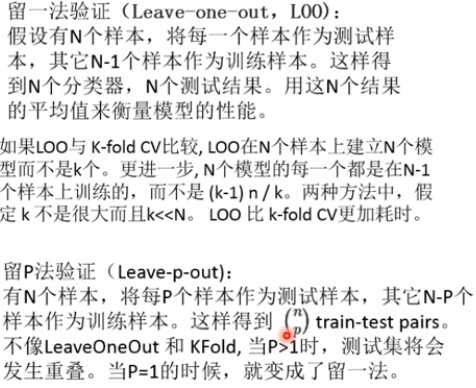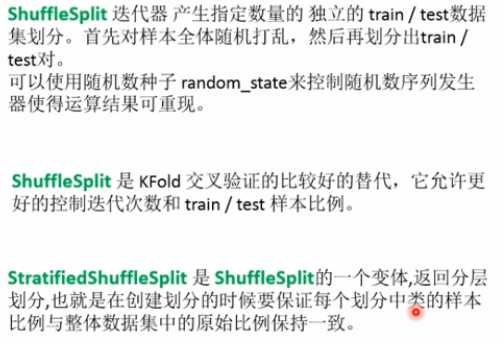标签:test [1] ati style span bsp array shuf state
一、sklearn数据集划分方法
有如下方法:
KFold,GroupKFold,StratifiedKFold,LeaveOneGroupOut,LeavePGroupsOut,LeaveOneOut,LeavePOut,ShuffleSplit,GroupShuffleSplit,StratifiedShuffleSplit,PredefinedSplit,TimeSeriesSplit,
数据集划分方法——K折交叉验证:KFold,GroupKFold,StratifiedKFold,

数据集划分方法——留一法:LeaveOneGroupOut,LeavePGroupsOut,LeaveOneOut,LeavePOut,

数据集划分方法——随机划分法:ShuffleSplit,GroupShuffleSplit,StratifiedShuffleSplit

KFold:
import numpy as np #KFold from sklearn.model_selection import KFold X=np.array([[1,2],[3,4],[5,6],[7,8],[9,10],[11,12]]) y=np.array([1,2,3,4,5,6]) kf=KFold(n_splits=2) #分成几个组 kf.get_n_splits(X) print(kf)
for train_index,test_index in kf.split(X):
print("Train Index:",train_index,",Test Index:",test_index)
X_train,X_test=X[train_index],X[test_index]
y_train,y_test=y[train_index],y[test_index]
#print(X_train,X_test,y_train,y_test)
#KFold(n_splits=2, random_state=None, shuffle=False) #Train Index: [3 4 5] ,Test Index: [0 1 2] #Train Index: [0 1 2] ,Test Index: [3 4 5]
GroupKFold:
import numpy as np from sklearn.model_selection import GroupKFold X=np.array([[1,2],[3,4],[5,6],[7,8],[9,10],[11,12]]) y=np.array([1,2,3,4,5,6]) groups=np.array([1,2,3,4,5,6]) group_kfold=GroupKFold(n_splits=2) group_kfold.get_n_splits(X,y,groups) print(group_kfold) for train_index,test_index in group_kfold.split(X,y,groups): print("Train Index:",train_index,",Test Index:",test_index) X_train,X_test=X[train_index],X[test_index] y_train,y_test=y[train_index],y[test_index] #print(X_train,X_test,y_train,y_test) #GroupKFold(n_splits=2) #Train Index: [0 2 4] ,Test Index: [1 3 5] #Train Index: [1 3 5] ,Test Index: [0 2 4]
stratifiedKFold:保证训练集中每一类的比例是相同的
import numpy as np from sklearn.model_selection import StratifiedKFold X=np.array([[1,2],[3,4],[5,6],[7,8],[9,10],[11,12]]) y=np.array([1,1,1,2,2,2]) skf=StratifiedKFold(n_splits=3) skf.get_n_splits(X,y) print(skf) for train_index,test_index in skf.split(X,y): print("Train Index:",train_index,",Test Index:",test_index) X_train,X_test=X[train_index],X[test_index] y_train,y_test=y[train_index],y[test_index] #print(X_train,X_test,y_train,y_test)
#StratifiedKFold(n_splits=3, random_state=None, shuffle=False)
#Train Index: [1 2 4 5] ,Test Index: [0 3]
#Train Index: [0 2 3 5] ,Test Index: [1 4]
#Train Index: [0 1 3 4] ,Test Index: [2 5]
leaveOneOut:测试集就留下一个
import numpy as np from sklearn.model_selection import LeaveOneOut X=np.array([[1,2],[3,4],[5,6],[7,8],[9,10],[11,12]]) y=np.array([1,2,3,4,5,6]) loo=LeaveOneOut() loo.get_n_splits(X) print(loo) for train_index,test_index in loo.split(X,y): print("Train Index:",train_index,",Test Index:",test_index) X_train,X_test=X[train_index],X[test_index] y_train,y_test=y[train_index],y[test_index] #print(X_train,X_test,y_train,y_test)
#LeaveOneOut()
#Train Index: [1 2 3 4 5] ,Test Index: [0]
#Train Index: [0 2 3 4 5] ,Test Index: [1]
#Train Index: [0 1 3 4 5] ,Test Index: [2]
#Train Index: [0 1 2 4 5] ,Test Index: [3]
#Train Index: [0 1 2 3 5] ,Test Index: [4]
#Train Index: [0 1 2 3 4] ,Test Index: [5
LeavePOut:测试集留下P个
import numpy as np from sklearn.model_selection import LeavePOut X=np.array([[1,2],[3,4],[5,6],[7,8],[9,10],[11,12]]) y=np.array([1,2,3,4,5,6]) lpo=LeavePOut(p=3) lpo.get_n_splits(X) print(lpo) for train_index,test_index in lpo.split(X,y): print("Train Index:",train_index,",Test Index:",test_index) X_train,X_test=X[train_index],X[test_index] y_train,y_test=y[train_index],y[test_index] #print(X_train,X_test,y_train,y_test) #LeavePOut(p=3) #Train Index: [3 4 5] ,Test Index: [0 1 2] #Train Index: [2 4 5] ,Test Index: [0 1 3] #Train Index: [2 3 5] ,Test Index: [0 1 4] #Train Index: [2 3 4] ,Test Index: [0 1 5] #Train Index: [1 4 5] ,Test Index: [0 2 3] #Train Index: [1 3 5] ,Test Index: [0 2 4] #Train Index: [1 3 4] ,Test Index: [0 2 5] #Train Index: [1 2 5] ,Test Index: [0 3 4] #Train Index: [1 2 4] ,Test Index: [0 3 5] #Train Index: [1 2 3] ,Test Index: [0 4 5] #Train Index: [0 4 5] ,Test Index: [1 2 3] #Train Index: [0 3 5] ,Test Index: [1 2 4] #Train Index: [0 3 4] ,Test Index: [1 2 5] #Train Index: [0 2 5] ,Test Index: [1 3 4] #Train Index: [0 2 4] ,Test Index: [1 3 5] #Train Index: [0 2 3] ,Test Index: [1 4 5] #Train Index: [0 1 5] ,Test Index: [2 3 4] #Train Index: [0 1 4] ,Test Index: [2 3 5] #Train Index: [0 1 3] ,Test Index: [2 4 5] #Train Index: [0 1 2] ,Test Index: [3 4 5]
##ShuffleSplit 把数据集打乱顺序,然后划分测试集和训练集,训练集额和测试集的比例随机选定,训练集和测试集的比例的和可以小于1
import numpy as np from sklearn.model_selection import ShuffleSplit X=np.array([[1,2],[3,4],[5,6],[7,8],[9,10],[11,12]]) y=np.array([1,2,3,4,5,6]) rs=ShuffleSplit(n_splits=3,test_size=.25,random_state=0) rs.get_n_splits(X) print(rs) for train_index,test_index in rs.split(X,y): print("Train Index:",train_index,",Test Index:",test_index) X_train,X_test=X[train_index],X[test_index] y_train,y_test=y[train_index],y[test_index] #print(X_train,X_test,y_train,y_test) print("==============================") rs=ShuffleSplit(n_splits=3,train_size=.5,test_size=.25,random_state=0) rs.get_n_splits(X) print(rs) for train_index,test_index in rs.split(X,y): print("Train Index:",train_index,",Test Index:",test_index)
#ShuffleSplit(n_splits=3, random_state=0, test_size=0.25, train_size=None)
#Train Index: [1 3 0 4] ,Test Index: [5 2]
#Train Index: [4 0 2 5] ,Test Index: [1 3]
#Train Index: [1 2 4 0] ,Test Index: [3 5]
#==============================
#ShuffleSplit(n_splits=3, random_state=0, test_size=0.25, train_size=0.5)
#Train Index: [1 3 0] ,Test Index: [5 2]
#Train Index: [4 0 2] ,Test Index: [1 3]
#Train Index: [1 2 4] ,Test Index: [3 5]
#StratifiedShuffleSplitShuffleSplit 把数据集打乱顺序,然后划分测试集和训练集,训练集额和测试集的比例随机选定,训练集和测试集的比例的和可以小于1,但是还要保证训练集中各类所占的比例是一样的
import numpy as np from sklearn.model_selection import StratifiedShuffleSplit X=np.array([[1,2],[3,4],[5,6],[7,8],[9,10],[11,12]]) y=np.array([1,2,1,2,1,2]) sss=StratifiedShuffleSplit(n_splits=3,test_size=.5,random_state=0) sss.get_n_splits(X,y) print(sss) for train_index,test_index in sss.split(X,y): print("Train Index:",train_index,",Test Index:",test_index) X_train,X_test=X[train_index],X[test_index] y_train,y_test=y[train_index],y[test_index] #print(X_train,X_test,y_train,y_test) #StratifiedShuffleSplit(n_splits=3, random_state=0, test_size=0.5,train_size=None) #Train Index: [5 4 1] ,Test Index: [3 2 0] #Train Index: [5 2 3] ,Test Index: [0 4 1] #Train Index: [5 0 4] ,Test Index: [3 1 2]
标签:test [1] ati style span bsp array shuf state
原文地址:http://www.cnblogs.com/nolonely/p/6985702.html